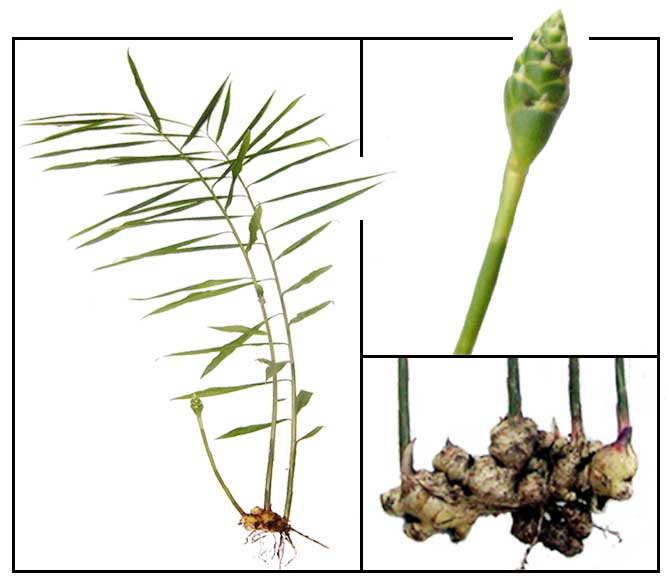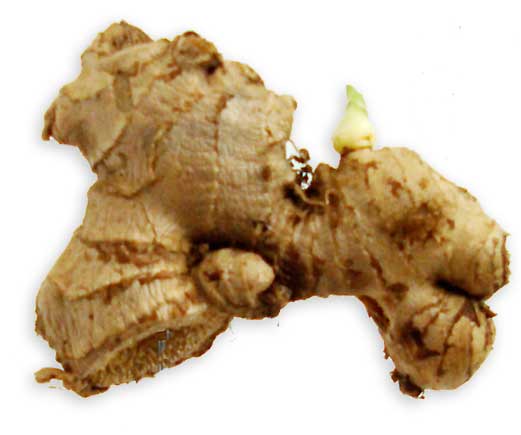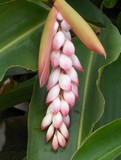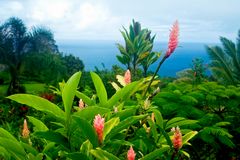MINISTRY OF AGRICULTURE
RESEARCH AND DEVELOPMENT DIVISION
RHIZOME ROT DISEASE OF GINGER
Prepared by Sheldon M. Elliott
Plant Protection Officer
Crop and Plant Protection Unit
July 2003
The spice trade generally considers Jamaica's ginger to be of the best quality and as a result, it commands a premium price on the world market. However, production has steadily declined overtime due mainly to rhizome rot disease in the major production areas. This has led many growers to abandon ginger cultivation.
Over the last five years the Plant Protection Unit of the Ministry of Agriculture has conducted research in the identification of the cause and control of this disease. The main pathogens associated with this disease are the fungus Fusarium spp. and the root knot nematode Meloidogyne sp.. Occasionally, the fungi Rhizoctonia solani, and Pythium sp., along with the bacterium Pseudomonas sp. have been isolated from diseased rhizomes.
Symptoms
Above-ground symptoms
Plants from infected rhizomes are stunted and yellow, lower leaves dry out and turn brown then eventually all aboveground shoots dry out completely. Plant collapse is very slow (up to several weeks).
Diseased ginger rhizomes
Diseased rhizomes show a brown discolouration, are normally shriveled in appearance and eventually decay leaving the outer shell intact with only fibrous internal tissue remaining.
•
Use planting material from a disease free source, e.g. Tissue culture plantlets.
•
Distribute progeny rhizomes from tissue culture plants to ginger growers in areas where the disease is absent or on lands previously not used for ginger production.
•
Multiply seed pieces by the use of tissue culture plants on lands that were not previously used for ginger production.
•
Practice crop rotation. Do not grow ginger for more than one crop on the same site.
The disease is spread unintentionally by the use of infected seed pieces from the previous crop, although these may appear normal and healthy. Hence, selecting clean material based on appearance may not be sufficient to control the disease.
Control Short term
•
Discard all seed pieces showing any cracking injury or rot.
•
Dip seed pieces in hot water at 50oC for 10 minutes if incidence of root knot was high in previous crop.
•
Dip seed pieces in Ridomil MZ (0.2%) or Topsin M (0.2%) for 20 minutes and allow to air dry prior to planting.
•
Keep land free from weeds at all times.
•
Destroy all crop refuse especially if disease was present.
•
Prepare land for planting well ahead of time and allow to burn.
Long term
For further information please contact:
Crop and Plant Protection Unit
Ministry of Agriculture
Bodles Research Station
Old Harbour P.O., St. Catherine
Jamaica, W.I.
Phone: (876) 983-2281/2267
Fax: (876) 983-2822
E-mail: ppu@moa.gov.jm
Rhizomes from tissue culture ginger plants
Top: harvested at 8 months
Bottom: harvested at 20 months
Left: Rhizomes from traditional seed piece harvested at 9 months
Right: Tissue culture ginger harvested at 20 months
Ginger Planter
Sunday, December 5, 2010
Thursday, September 16, 2010
How to Plant a Red Ginger Plant From a Root Cutting
Source:
By Kate Aldrich, eHow Contributor
updated: August 21, 2009
i hope you learn more about ginger. this blog will serve you as a guide on how to plant red ginger..
enjoy reading my blog...
I want to do this! What's This?
Red ginger plants are prized for their shiny, green leaves and white flowers with stunning red bracts, which look beautiful in flower arrangements. Planting red ginger root cuttings is the easiest way to grow your own red ginger plant ... short of buying an actual plant, of course. The red ginger plant loves heat and humidity, so if you don't live in hardiness zone 11, be sure to keep your red ginger in a greenhouse.
Difficulty: Moderately Easy
Instructions
Things You'll Need:
* Red ginger plant root cutting
* Planter (if not planting in the ground)
* Loam (sandy or clay)
* Water-soluble fertilizer
1.prepare your red ginger root cutting for planting by loosening the roots so they're not intertwined with each other.
2.Fill your planter with loam; anything from sandy to clay is fine for red ginger. If you're planting right in the ground, add a top layer of loam.
3.Plant the root cutting two inches below the surface of the soil. It's OK if the green growth is above the soil line.
4.Use a water-soluble fertilizer immediately after planting and repeat every two weeks during the growing season (approximately March to September).
5.Water your newly planted red ginger root cutting generously. Soak the soil with each watering and water again when the soil feels dry to the touch an inch deep.
Tips & Warnings
*
If you test your soil pH, aim for a pH between 6 and 7.5 for red ginger. Red ginger plants are heat and humidity lovers, but they prefer partial shade (such as that provided by tree leaves growing overhead).
Read more: How to Plant a Red Ginger Plant From a Root Cutting | eHow.com http://www.ehow.com/how_5026953_plant-ginger-plant-root-cutting.html#ixzz0zkGoSbQh
By Kate Aldrich, eHow Contributor
updated: August 21, 2009
i hope you learn more about ginger. this blog will serve you as a guide on how to plant red ginger..
enjoy reading my blog...
I want to do this! What's This?
Red ginger plants are prized for their shiny, green leaves and white flowers with stunning red bracts, which look beautiful in flower arrangements. Planting red ginger root cuttings is the easiest way to grow your own red ginger plant ... short of buying an actual plant, of course. The red ginger plant loves heat and humidity, so if you don't live in hardiness zone 11, be sure to keep your red ginger in a greenhouse.
Difficulty: Moderately Easy
Instructions
Things You'll Need:
* Red ginger plant root cutting
* Planter (if not planting in the ground)
* Loam (sandy or clay)
* Water-soluble fertilizer
1.prepare your red ginger root cutting for planting by loosening the roots so they're not intertwined with each other.
2.Fill your planter with loam; anything from sandy to clay is fine for red ginger. If you're planting right in the ground, add a top layer of loam.
3.Plant the root cutting two inches below the surface of the soil. It's OK if the green growth is above the soil line.
4.Use a water-soluble fertilizer immediately after planting and repeat every two weeks during the growing season (approximately March to September).
5.Water your newly planted red ginger root cutting generously. Soak the soil with each watering and water again when the soil feels dry to the touch an inch deep.
Tips & Warnings
*
If you test your soil pH, aim for a pH between 6 and 7.5 for red ginger. Red ginger plants are heat and humidity lovers, but they prefer partial shade (such as that provided by tree leaves growing overhead).
Read more: How to Plant a Red Ginger Plant From a Root Cutting | eHow.com http://www.ehow.com/how_5026953_plant-ginger-plant-root-cutting.html#ixzz0zkGoSbQh
Monday, September 13, 2010
Ginger
| Other scientific names | Common names |
| Amomum zingiber Linn. | Agat (Pamp., Pang.) |
| Zingiber blancoi Hassk. | Baseng (Ilk.) |
| Gengibre (Span.) | |
| Laial (Sbl.) | |
| Laiya (If.) | |
| Laya (Ilk., Bon., Ibn., It.) | |
| Luy-a (Bis.) | |
| Luya (Tag.) | |
| Chiang-t'i (Chin.) | |
| Ginger (Engl.) |

| Botany Erect, smooth plant with thickened and aromatic rootstocks. Leafy stems are 0.4 to 1 meter high. Leaves are distichous, lanceolate to linear-lanceolate, 15-25 cm long, and 2 cm wide or less. Scape from rootstock is erect, 15-25 cm high, covered with imbricate bracts. Calyx is 1 cm long. Corolla is greenish-yellow with a tube less than 2 cm long.  Distribution DistributionWidely cultivated in the Philippines. Parts utilized Tops, leaves and edible roots. Constituents • Pungent principles, mainly zingerone and shogaol, provides the characteristic taste. • The most biologically active phenolic compounds, gingerols and shogaols, are found in the root. • Volatile oil, 1.23 to 3% - gingerol, zingerone, zingiberene, cineol, borneol, phellandrene, citral, zingiberene, linalool, geraniol, chavicol, vanillyl alcohol, camphene; resin. Properties • Extracts and active constituents have shown potent antioxidant, antiinflammatory, antimutagenic, antimicrobial and possible anticancer activities. • Considered adaptogenic, anodyne, anthelmintic, antiallergenic, antibacterial, anticoagulant, anticonvulsant, antidepressant, antifungal, antithrombotic, antitumore, antiulcer, aphrodisiac, carminative, diuretic, rubifacient, anti-platelet aggregation, hypolipidemic, thermoregulatory. Uses Nutritional Flavoring for ginger ale, ginger beer, and other beverages. Salabat, a native beverage, is prepared from the rhizomes. A prominent condiment in Filipino cuisine. Taken with rocksalt before meals is cleansing to the tongue and throat and increases the appetite. Folkloric Antiseptic: Prepare tincture of dried rhizome with 70% alcohol (not rubbing alchol) and apply on superficial cuts and wounds or use juice from fresh rhizome. As digestive aid and for flatulence and tympanism: Take decoction of the rhizome as tea. Rheumatism: Pound roasted rhizome, mix with oil and apply locally. Sore throat and hoarseness : Take warm decoction of the rhizome as ginger tea (salabat) or chew a small piece of rhizome. Cough remedy and carminative. Diuretic. Hangovers. Headaches: Ginger plaster (bruised ginger in water to the consistency of poultice) applied to the forehead. Same preparation may be helpful for toothaches and facial pain. In Ayurvedic medicine, used for inflammation and rheumatism. In Chinese folk medicine, pulverized fresh ginger used for baldness and vitiligo. Juice from fresh root used for treatment of burns. New uses • Motion Sickness / Pregnancy-related Nausea: Antiemetic properties. Used for Nausea, motion sickenss (1 gm taken 1/2 hour before the voyage). Stimulates digestion. Possibly antiinflammatory. Preparations • Ginger tea Ginger tea preparation, the Chinese way : Bring one cup of water to boil. Add one teaspoon of the roasted (parched and browned) rice and a small piece of ginger root. Boil for one minute. Let stand to cool for drinking. (Preparation of dried rice: Pour enough water to cover 1/2 cup white rice in a flat dish; and let stand overnight. In the morning, drain off the excess water. Roast the rice in a dry pan, stirring constantly until parched and brown. Store in a glass jar for future use, tightly covered to keep moisture out.) • Ginger lozenges • Wash and peel the ginger, then mince. • Spread and air-dry for a day or oven-dry at 250 C. • Grind and strain the dried ginger. * In a mortar, mix 1 cup ground giner and 1 cup confectioner's sugar. • Pound and mix while gradually adding water until a pulp is formed. • Level the pulp on a board lined with wax paper. • Using a mold, make balls from the pulp and wrap each lozenge in aluminum foil. How to make medicated candies from powdered rhizomes Materialls, proportion and procedure Go to Traditional and Modern Medicine http://traditionalmed.blogspot.com/2007/01/how-to-prepare-ginger-lozenges.html Studies • Prokinetic: Pharmacological basis for the medicinal use of ginger in gastrointestinal disorders: Study confirmed prokinetic activity of the extract. Spasmolytic constituents may explain its use in hyperactive states as in colic and diarrhea. • Antidiarrheal: Study results indicate that in the absence of antimicrobial action, Z officinale exhibits its antidiarrheal activity by affecting bacterial and host cell metabolism. • Antibacterial: Antibacterial Activity Of Allium cepa (Onions) And Zingiber officinale (Ginger) On Staphylococcus aureus And Pseudomonas aeruginosa Isolated From High Vaginal Swab: Thes study showed both plant had antibacterial activity on the test organisms, ginger having more inhibitory effect, and confirming their folkloric use. • Antiinflammtory / Anti-thrombotic: The use of ginger (Zingiber officinale Rosc.) as a potential anti-inflammatory and antithrombotic agent: Study suggests ginger can be used as a cholesterol-lowering, anti-thrombotic and anti-inflammatory agent. • Antioxidant / Anticancer: Study showed Zingiber officinale may exert its anticancer effect by replacing the action of superoxide dismutase, glutathione peroxidase and catalase in removing superoxide radicals and hydrogen peroxide causing oxidative damage to cells. • Antibacterial (Garlic/Ginger) Synergism: Study investigated the therapeutic effects of ginger and garlic against Klebsiella pneumonia, whether the combined extract could be synergistic or antagonistic in rats. Study showed a synergistic relationship, garlic ameliorating the efficacy of giner only against Klebsiella infection. • Anti-Inflammatory / Anti-Arthritis / Prostaglandin Inhibition: Study suggests one of the mechanisms by which ginger shows ameliorative effects could be through inhibition of prostaglandin and leukotrine biosynthesis - as a dual inhibitor of eicosanoid biosynthesis. • Gastroprotective: Study results suggest cytoprotective and anti-ulcerogenic effects with significant protection against ethanol-, HCl-, NaOH-induced gastric lesions and prevention of the occurrence of gastric ulcers induced by non-steroidal anti-inflammatory drugs and hypothermic restrain stress. • Decreased Sperm Motility: Study results conclude that ginger can induce toxic effects on sperm parameters, ie, a lower percentage of motility and grading when methanolic ginger is added to semen fluid. • Hepatoprotective: Study of the ethanol extract of Z officinale showed protective effect against paracetamol-induced hepatotoxicity with better protective effect at higher dose levels. • Anti-Aging: Study in mice showed ginger extract significantly reduced the development of atherosclerotic lesions and lowered LDL-cholesterol. • Anti-Inflammatory / Analgesic: Study of rhizome extract in Swiss mice showed anti-inflammatory and analgesic properties with significant inhibition of carrageenan-induced paw edema and reduction of writhing induced by acetic acid. • Pregnancy-Related Nausea: Reasonable evidence suggests that ginger roots is effective in reducing pregnancy-related nausea. However, there is conflicting data on its efficacy for preventing motion sickness or post-operative nausea. • Anti-Inflammatory / Antibacterial / Hypoglycemic / Analgesic: Study of ethanol extract showed (1) reduction of carrageenan-induced paw swelling and yeast-induced fever (2) blood glucose lowering (3) inhibition of gram- and gram+ bacteria (4) dose-dependent prostaglandin release inhibition. • Analgesic: Study demonstrated the daily consumption of raw and heat-treated ginger resulted in moderate to large reduction in muscle pain followoing exercise-induced muscle injury. The findings agree with findings of ginger's hypoalgesic effects in osteoarthritic patients. • Antiarthritic: Study of the alcoholic extract of ZO can ameliorate inflammatory processes in rat collagen-induced arthritis, together with reduction of serum levels of interleukins, TNF, and anti-CII antibodies. It also showed to be superior to indomethacin 2 mg/kg/d at most measured parameters. The extract presents an alternative to NSAID use in RA. Side effects • No known side effects or drug interactions. • The German Commission E recommends that it be avoided during pregnancy due to possible inhibition of testosterone binding in the fetus. • The use in pregnancy for hyperemesis gravidarum is controversial. Use for nausea during pregnancy is not recommended. • Should not be used by pregnant women with a history of bleeding disorders and miscarriages. Anticogulang precaution Decreases platelet adhesiveness; therefore, should be used with caution by patients on anticoagulant therapy. Availability Wild-crafted. Popular condiment and perennial market produce. Candied ginger and lozenges. Dried powdered gingeroot. Tinctures, tablets, capsules, syrups and teas in the cybermarket. |
Sunday, September 12, 2010
Ginger - grow it
hi bloggers.. now you learn again in my blog about ginger grow..enjoy and learn many more in my blog...
Ginger is a low-growing tropical plant which is easily grown indoors during the summer months in the UK. You can grow ginger plants from green ginger which you buy from supermarkets, although you are not likely to produce a big crop of rhizhomes.
Growing outdoors in the tropics, it needs a minimum annual rainfall of 150cm, temperatures of 30°C or over, a short dry season and a deep fertile soil. It usually takes nine months to produce a crop.
Growing outdoors in the tropics, it needs a minimum annual rainfall of 150cm, temperatures of 30°C or over, a short dry season and a deep fertile soil. It usually takes nine months to produce a crop.
HardinessBest grown as an annual in the UK. Cannot be grown outdoors even in the hottest part of summer: minimum temperature around 28°C. |

PropagationPropagation: Grown from the end 'finger' pieces broken off a root or 'hand' of ginger. Existing ginger plants can be divided and the roots grown on, although they are difficult to keep alive during the UK winter because of low light levels. |

CultivationIn early spring or late winter, find some fresh ginger in the shops. Choose fingers which have a shoot bud developing - this looks like a small pyramidal horn at the end of the root - and cut off at least 5cm from this bud. Bury the finger bud upwards in a 20cm pot of loam-based compost. Keep warm and constantly moist during the growing season. Move to a larger pot as the plant grows, (ultimately you might need a 35cm diameter pot if your ginger is growing very well.) Once the ginger has started to grow, feed every two to three weeks with a general pot-plant feed. In the autumn, reduce the watering and let the pots dry out, which will encourage the plants to form rhizhomes. Lift the rhizhomes carefully and use in cooking. |

PestsUsually healthy, although red spider mite can be an occasional problem. Increasing the humidity by misting plants twice daily with warm water helps discourage these pests. |

Plant sourcesPlantfinder lists Kobakoba. Ginger root bought in markets and the supermarket usually shoots readily. |

Plant safetyThere are no safety concerns. |
Saturday, September 11, 2010
Ginger - history
hello my readers. i hope you learn in my blog
Ginger has been grown in tropical Asia since ancient times. The ancient use of ginger as a flavouring pre-dates historical records.
Origins
 |
| Ginger root. |
Potted ginger plants were carried on local vessels travelling the maritime trade routes of the Indian Ocean and South China Sea in the 5th century AD and probably before. The plants would have rapidly spread to many other countries along the way.
In the 16th century ginger was introduced to Africa and the Caribbean. It is now cultivated throughout the humid tropics.
History
Ginger has a long history of use in South Asia, both in dried and fresh form. The Hindu epic Mahabharata written around the 4th century BC describes a meal where meat is stewed with ginger and other spices. It was also an important plant in the traditional Indian system of Ayurvedic medicine.In the Manasollasa literature written in the 11th century AD ginger was mentioned as a flavouring for buttermilk drinks. Its use as a food became much more widespread by the 13th century AD with the advent of Muslim rule in India. It became popular to prepare meat dishes and drinks using ginger pastes. Fruit juices, tea, buttermilk and curd products were spiced with ginger.
Ginger was also highly important as an article of trade and was exported from India to the Roman empire 2000 years ago where it was valued more for its medicinal properties than as an ingredient in cookery.
It continued as an article of trade to Europe even after the fall of the Roman empire, with Arab merchants controlling the trade in ginger and other spices for centuries. By medieval times, it was being imported in preserved form, to be used in sweets.
Together with black pepper, ginger was one of the most commonly traded spices during the 13th and 14th centuries. Arabs carried the rhizomes on their voyages to East Africa to plant at coastal settlements and on Zanzibar. During this time in England, ginger was sought after, and one pound in weight of ginger was equivalent to the cost of a sheep.
Ginger - plant profile
Names
Ginger (English)Srngaveram (Sanskrit)
Adrak (Hindi, Urdu)
Sont (Hindi, dried ground ginger)
Botanical name: Zingiber officinale
Family: Zingiberaceae, the ginger family
The closely related Zingiber montanum and Zingiber zerumbet are also cultivated in India. Like ginger, they are used as a spice.
Botanical names are often derived from their ancient names. The word Zingiber is a good example. It is thought to come from the Sanskrit word singabera which was from Arabic and Greek words meaning 'shaped like a horn'. It probably got its name because the rhizomes look like deer's antlers.
The plant
Ginger plants can grow to about 1 m tall. The upright shoots sprout from the rhizome at the base of the plant. Rhizomes - knobbly and fleshy, covered in ring-like scars. This is the important part for food and medicine. Although the rhizomes grow underground, they are swollen stems, not roots. This is why fresh ginger is often referred to as 'stem ginger'.Flowers - the flowering spikes sprout directly from the rhizomes and are about 30 cm long. The flowers are purple with a cream-blotched base.
Fruits - red in colour. Each has three chambers containing several small black seeds. Ginger plants that are cultivated in commercial plantations don't usually bear fruit.
now you learn what is ginger?
Thursday, September 9, 2010
When does ginger flower?
When growing ginger as outlined above you won't see any flowers. A clump needs to be about two years old to flower. So if you want to see your ginger flower leave it in the ground, and just dig very carefully at the edges of it to harvest bits here and there.
The flowers of culinary ginger are green and insignificant anyway.

 There are however some spectacular flowering gingers. If you are after great flowers get some of those. They are grown exactly like the culinary ginger, just skip the harvest :-).
There are however some spectacular flowering gingers. If you are after great flowers get some of those. They are grown exactly like the culinary ginger, just skip the harvest :-).
There's also a pretty variegated ginger, with white and green striped leaves. All the ornamental varieties are evergreen in the tropics (meaning they don't die down like the culinary ginger).
The flowers of culinary ginger are green and insignificant anyway.

 There are however some spectacular flowering gingers. If you are after great flowers get some of those. They are grown exactly like the culinary ginger, just skip the harvest :-).
There are however some spectacular flowering gingers. If you are after great flowers get some of those. They are grown exactly like the culinary ginger, just skip the harvest :-).There's also a pretty variegated ginger, with white and green striped leaves. All the ornamental varieties are evergreen in the tropics (meaning they don't die down like the culinary ginger).
Subscribe to:
Comments (Atom)




